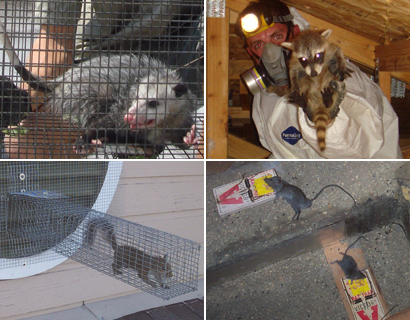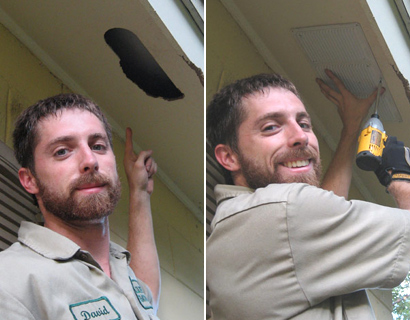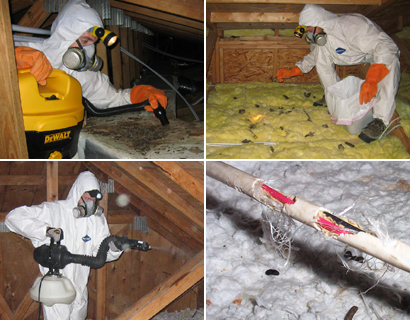- How We Solve Wildlife Problems
How We Solve Chicago Wildlife Problems
INSPECTION: Once on site, we will perform a full inspection of your home and property. This allows us to use the correct strategy and traps. If the animals are in an attic, a full building inspection is crucial, including the following:
- All ground-level areas, such as piper or A/C line entry & exit areas, A/C chase bottoms, ground-level vents, etc.
- All mid-level areas, such as dryer vents, siding gaps, first floor eaves or dormers, etc.
- We inspect the entire roof, including all plumbing stacks, ridge caps, vents, and other potential gaps or holes.
- We also inspect inside your attic, to identify animals and damage they have caused.
- If the animals are outside, we notice many subtle clues that will assist us in a successful strategy.
TRAPPING, EXCLUSION, REMOVAL: Once we understand what animal species we are dealing with, and the problem, we use the most effective means of removing the animals. We use dozens of different types of traps.
- Trapping - If trapping the animal(s) in live cage traps, trap type, set, and location are crucial to success.
- Exclusion - Oftentimes, we are able to simply set one-way doors or other exclusion devices that allow the animals inside a building to safely exit, but never get back inside.
- Removal By Hand - Sometimes we actually remove animals by hand, or with special tools like snare poles.
- The Law - In all cases, we obey state and local laws regarding wildlife, but aim to take the most humane approach.
ENTRY HOLE REPAIRS: Repairs are a crucial step in the wildlife removal process. In many cases, such as bat or rodent control, the job cannot be performed without detailed repairs, and in all cases, sealing the entry holes shut ensures that no future wildlife will ever enter your home.
- 100% of the entry holes must be found, and sealed shut, or the job is not complete.
- Our repairs are professional contractor grade, look good, and when applicable we use steel, which rodents such as rats or squirrels are unable to chew through.
- We give a written guarantee on our repairs against any future animal entry.
ATTIC DECONTAMINATION SERVICES: It may be desirable to clean your attic after we've removed the animals. They can leave behind large amounts of droppings, urine, hair, oils, food, nesting material, and so on. These remnants can attract insects like cockroaches, and the scent left behind can encourage new animals to chew their way into your house. You might experience odor problems from the waste. It's possible that mold will grow on waste areas.
- We remove or vacuum all droppings, or remove all the soiled insulation.
- We fog the attic with a special enzyme-based cleaner that destroys any organic matter and deodorizes the space.
- We repair damage, such as ductwork, electrical wires, pipes, insulation, and more.
Chicago is near lake Michigan, and of course our cold climate means that wildlife activity slows down in the winter - but squirrels and rats are still very active during this time, and raccoons occasionally show up. In the summer, skunks, groundhogs, moles, and bats are more active. We service the greater Chicago metropolitan area, including Cook County, DuPage County, Kane County, Kendall County, Lake County, McHenry County and Will County. We service surrounding towns such as Aurora, Elgin, Joliet, Naperville, Arlington Heights, Berwyn, Bolingbrook, Cicero, Des Plaines, Evanston, Hoffman Estates, Mount Prospect, Oak Lawn, Oak Park, Orland Park, Palatine, Schaumburg, Skokie, Tinley Park, Waukegan, Wheaton, Glenview, and more. Go back to the Chicago wildlife control home page. This month's wildlife how-to article: How to get raccoons out of the attic
We have all seen the cute cartoons of raccoons and thought that they were adorable little critters! However, it’s a completely different story when you have one living in your attic. Aside from the noise and the annoyance that these creatures bring with them, they are also going to go through your garbage can, steal your food (and that of your pets) and generally freak your pets out. If you don’t like the fact that your dog is going berserk every night, you should probably get rid of the raccoon!
Obviously, if you have taken preventative methods, you won’t have a raccoon problem, but it is easy to let these things slide, so instead you should look at trapping them. Before you start with this quest however, you need to ask two questions – is it legal to catch and release raccoons in your state? If the answer is no, call upon a professional. Secondly – do you know that the problem is just one raccoon? If the answer is no – you could have babies. The last thing you want to do is to get rid of the mother because then you will have a starving baby raccoon situation on your hands, and that is NOT pleasant! In short – if you have the opportunity, just call a specialist – the job will be completed properly and efficiently, taking most of the hard work out of your hands.
You need to remember if you are trapping the animal yourself, you need to be smart. These animals are not just going to walk right into your trap and let you release it back into the wild. It will be a struggle and you are going to have to be patient. You also need to ensure that you pick the right bait so that you don’t accidentally catch your household pet or other animal that may be passing around your land.
For the most part, you can “encourage” your raccoon to leave if you make the situation that he or she lives in most undesirable. This means taking away their food source. If you have a garbage can that the animal regularly roots through, make sure that the lid is on the can and it is tied down with something. You should try using bungee ropes because they (and other creatures) will often nibble through materials such as string or rope. You should also consider having any sources of food out of the way. This means never leaving food on your kitchen work surface or having pet food out on the floor. Once you have eaten, get rid of the leftovers or put them in the fridge. If your pet has finished eating, don’t leave the food in the bowl on the floor; take it away and dispose of it or put any dried food back in the bag. The more food you leave around, the more desirable you are making your home for unwanted visitors, but if you take the food situation out of the equation, your raccoon will more than likely give up and find somewhere else to call its home.
Other Chicago animal pest control topics:
Bat Removal Methods
Information About Chicago Rats
Do We Kill Squirrels?





